It’s a rare double heron day at the only national park dedicated to preserving aquatic plants. A Yellow-crowned Night Heron is stalking crustaceans in a water lily pond straight out of a Claude Monet painting. A Green Heron clutching a lotus stalk stands surrounded by pink and white flowers, huge, cup-shaped leaves and bright green pods that look like shower heads.
We’re just seven miles from the White House.
“It’s really popular for D.C. people to say it’s a hidden gem, but it really does feel like a hidden gem,” says Solomon Jeong, an intern ranger who’s leading a morning tour of Kenilworth Park & Aquatic Gardens.
“I just really like how serene it is here.”

When the lotus seed pod drops its petals, it turns brown and often gets dried and reused in floral arrangements/Jennifer Bain
Though not as well-known as the spring cherry blossoms, the flowers here are about to reach “peak bloom.” The annual Lotus & Water Lily Festival will draw crowds from July 19 to 21, but even on this weekday in late June the park is filled with birders, photographers, picnickers and nature lovers.
For a break from the heat wave, I step inside the air-conditioned visitor center to learn about the disabled war veteran whose flower hobby became a business, the trailblazing daughter who fought to save this precious place from dredging, and the community that lobbied for environmental justice.
After losing part of his right arm in the Civil War, Walter B. Shaw from Vinalhaven, Maine learned to write with his left hand. A Treasury Department job brought him to Washington, D.C. and he and his wife bought 33 acres of land — east of the Anacostia River — from her parents in 1879 for $2,500. They went on to have three children.

Photographing water lilies in the ponds at Kenilworth Park & Aquatic Gardens is addictive, since each new one is more beautiful than the last one/Jennifer Bain
Pining for the beauty of his home state, Walter imported 12 white water lilies from Maine and planted them in an abandoned ice pond. The lilies quickly crowded the pond, so he used his good arm and a shovel to excavate more ponds. With more flowers than he could give away, Walter soon heeded the advice of friends to sell them.
Shaw Gardens made $33 in profits in 1889 and $125 the year after. Walter’s hobby quickly became more profitable than his government job and he became a full-time aquatic gardener.
Walter bought plants from around the world, experimented with cross breeding water lilies and expanded into lotus flowers. He sold to locals and shipped flowers as far as New York, Boston, Philadelphia and Chicago.
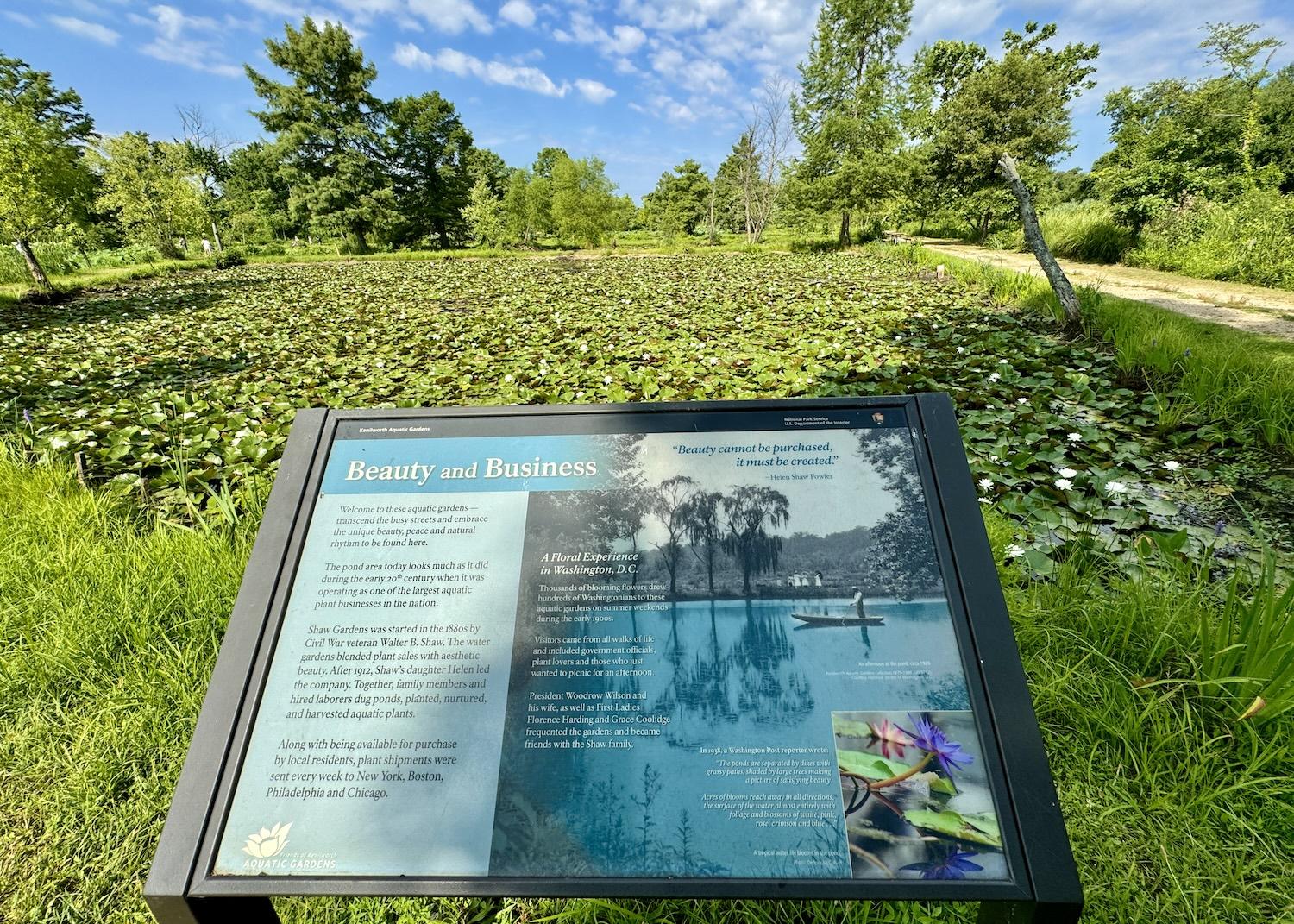
An interpretive sign at a water lily pond speaks to how "beauty and business" intertwined here at this business turned NPS unit/Jennifer Bain
But the wisest thing Walter did was hand over the reins to his daughter Helen in 1912 and then stay active in the business until his 1921 death. They hired laborers, dug more ponds and built two steam-heated greenhouses to nurture tropical lilies in the winter before they were transferred into display pools and then the main ponds.
The Shaws divided portions of the tidal marsh into irregular-shaped ponds separate by grass paths called dikes. Each pond is connected to at least two others by underground dikes. Several ponds are connected directly to the tidal marsh by the same type of pipes that are used to regulate water levels. The interconnecting pipe system keeps pond levels constant.
Helen, an astute businesswoman, traveled the world hunting for plants and transformed Kenilworth into what it is today. The widow, whose only child died of disease, once said of her lilies: “I love them as I would my own children.”
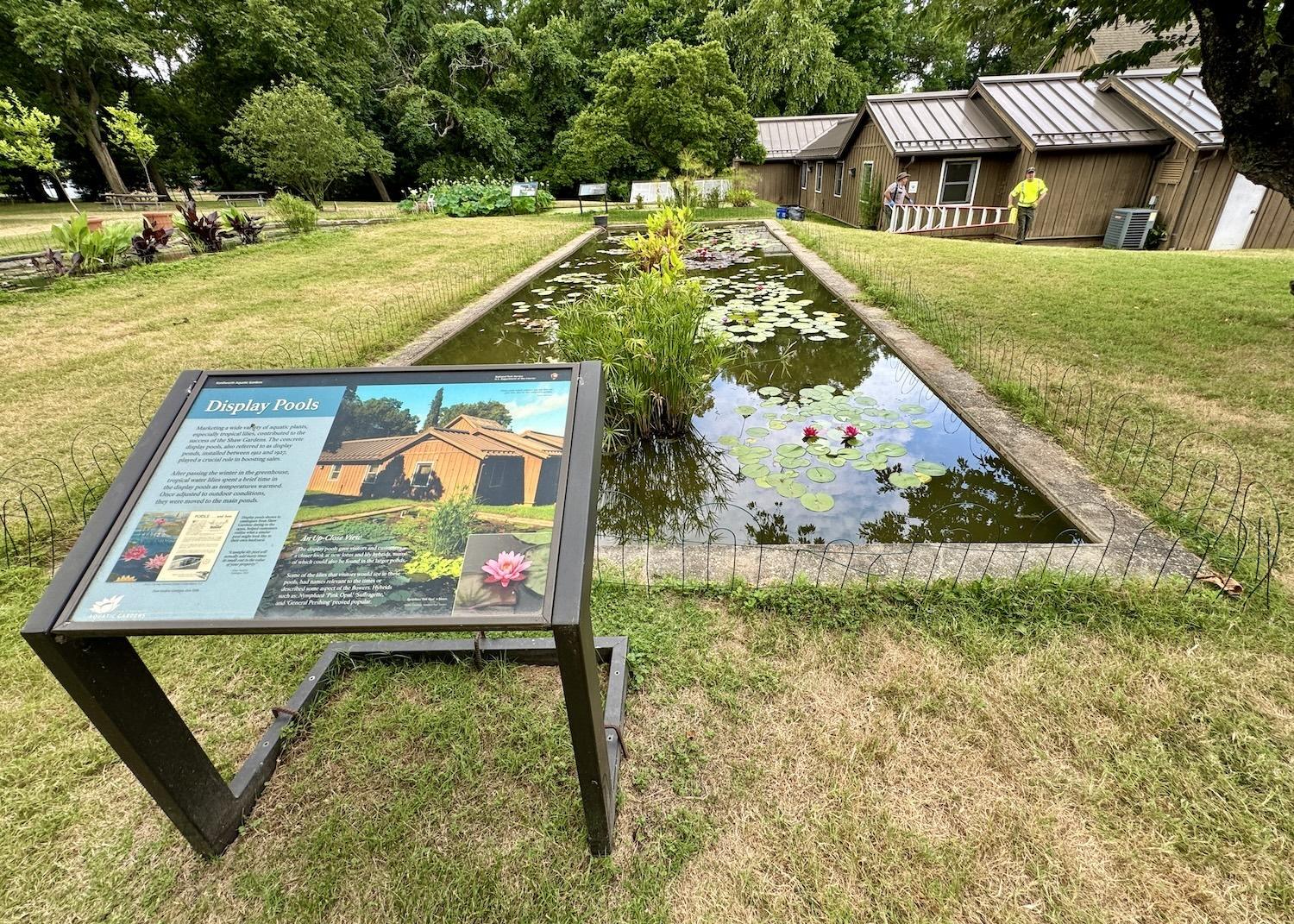
The NPS has maintained the display pools that Shaw Gardens started decades ago. They're tucked away behind the visitor center/Jennifer Bain
Shaw Gardens was progressive for its time. Helen employed African Americans and was reportedly the first woman in D.C. to get a commercial driver’s license in 1912. The garden catalog featured her water lily paintings so customers could see what they were buying when the flowers weren’t in bloom.
Washingtonians came for picnic breakfasts, and walked the gardens before the lilies close in the hot afternoon sun. Presidents Woodrow Wilson and Calvin Coolidge, and their wives, were regulars and friends.
But despite all this good work, the gardens came under threat.

A boardwalk at Kenilworth Park & Aquatic Gardens leads to Kenilworth Marsh. It survived dredging and is the spot where the Anacostia Watershed Society releases freshwater mussels/Jennifer Bain
Congress authorized the U.S. Army Corps of Engineers to dredge the river, and fill in the marsh and swamp areas along it, to control malaria-bearing mosquitoes. Helen and her brother rallied the Kenilworth Citizen’s Association and Congress. In 1938, the federal government bought the gardens for $15,000 to preserve them as part of Anacostia Park.
The National Park Service took over (and the parks now share a superintendent), but Helen was allowed to rent her home on the property, helped train park personnel and gave occasional tours. After she died at 82 in 1957, her home was demolished.
But the Shaws' legacy lives on. The greenhouses are still in use. The sales office is now a visitor center. The park tends to 44-odd ponds. It's free to visit and open year-round. Rangers lead regular garden tours and bird walks.

Solomon Jeong is a Conservation Legacy intern park ranger at Kenilworth Park & Aquatic Gardens. He poses with lotus flowers/Jennifer Bain
“All I ask is that we watch from afar,” says Jeong as he starts our tour and outlines what flora and fauna we might see. “A lot of people do try to pick the flowers.”
The fact that Kenilworth is called a “park” and “aquatic gardens” instead of a “national park” confuses people. The NPS manages 429 individual parks covering more than 85 million acres in all 50 states, the District of Columbia and U.S. territories. There are about 20 naming designations ranging from national parks and national parkways to national monuments and — simply — parks
“Regardless of designation, all park lands within the National Park System are equally protected,” says Michael Donato, chief of staff for National Capital Parks — East. Under “leave no trace principles,” that means observing wildlife from a distance and leaving rocks, plants and other natural objects as you find them.

To protect a beaver lodge, the NPS has closed the area around the water lily pond where it was built at Kenilworth Park & Aquatic Gardens/Jennifer Bain
“We eat pollen and nectar from flowers. Please don’t take our food,” is how a colorful sign with cartoon bumblebees and butterflies dining on flowers gently relays this message. “Leave the park as you found it & remember to use the trash cans!”
As we tour the gardens, our Conservation Legacy intern ranger provides a crash course in lotus and lilies, and points out an off-limits area where a beaver has built a lodge. “We let it be, do its thing and thrive,” says Jeong. “Honestly, beavers are very important to marshes.”
Jim Street, a park guide, tags along taking photos. “I got the Yellow-crowned Night Heron,” he enthuses, “but I didn’t get the a good one of the Green Heron.” His advice to visitors? Pack a monopod or tripod and patience. He recently caught a video of a heron eating a crayfish.
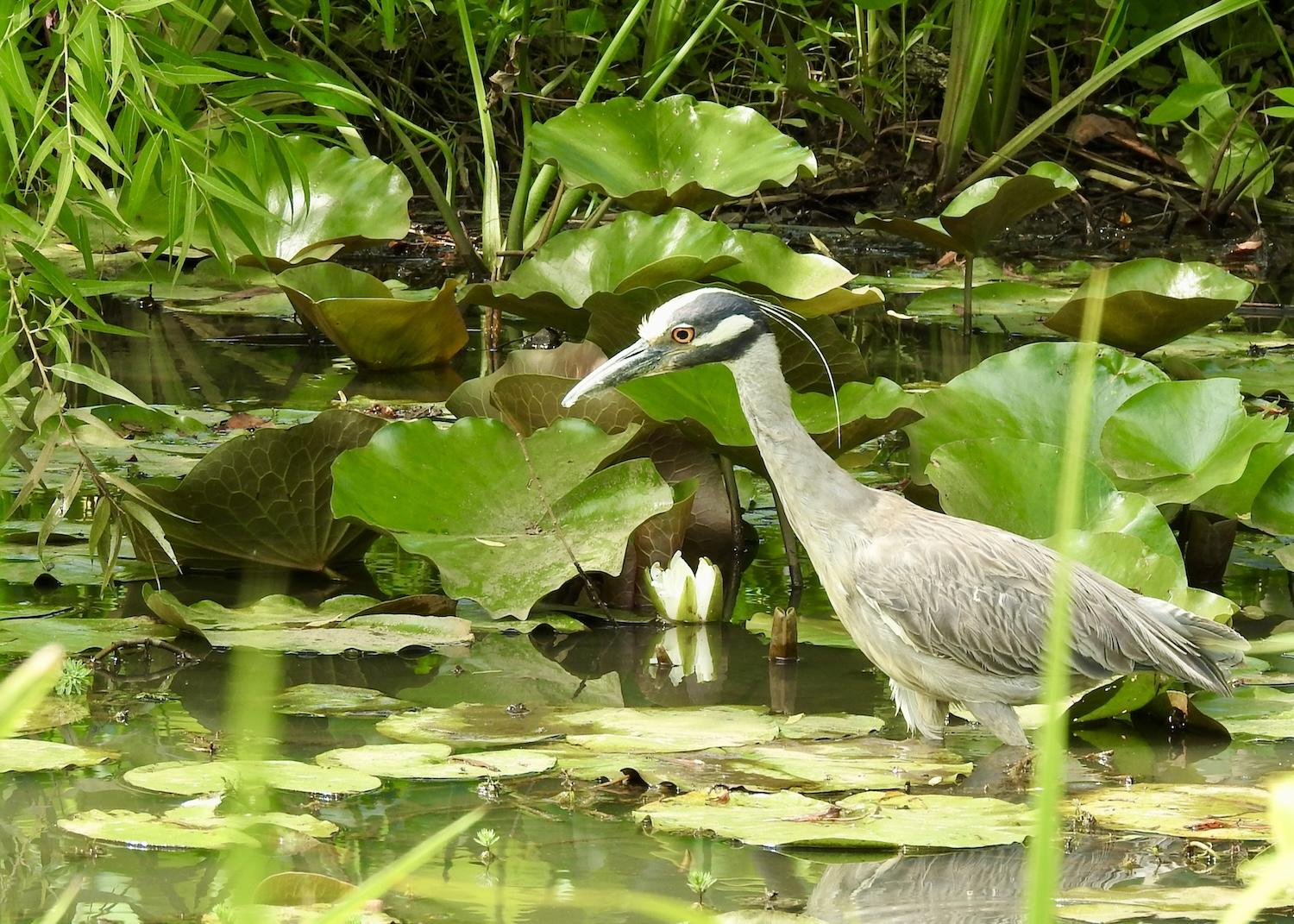
A Yellow-crowned Night Heron has been delighting visitors at Kenilworth Park & Aquatic Gardens this summer/Jennifer Bain
We learn how Kenilworth sits on the ancestral homeland of the Nacotchtank people who were forcibly removed from their land, and how "Anacostia" is derived from their name. We hear how the freshwater tidal Anacostia River is part of a larger watershed that flows into the Potomac River and nourishes the Chesapeake Bay.
Along a path from the parking lot into the park, lawn signs detail the history of the neighborhood and how locals have crusaded for environmental justice.
Starting in the 1940s, the area that once forced enslaved labor to work farmland transitioned to industry. Power plants were built along the river. Open trash burning in a dump covered the community with smoke until the 1960s. Homes and community centers were demolished for a highway. Most local facilities were segregated until the 1950s. Increased pollution and disruption, and increasingly integrated spaces, caused white flight.

Birders and photographers flock to the lotus ponds at Kenilworth Park & Aquatic Gardens once they start blooming/Jennifer Bain
“This side of the river bore the brunt of the environmental degradation,” Jeong point out, acknowledging how wealthier and whiter riverfront neighborhoods in the D.C. area obviously fared better.
After years of neglect, signs say, the Anacostia River was known as the “forgotten river” and was one of America's most polluted rivers. Industry and sewage waste along with trash run-off clogged the river and damaged wildlife habitats.
Community leaders have fought for a safe and clean river and environmental justice. During the 1990s, more than 32 acres of tidal wetland were restored and native vegetation was reintroduced to provide habitat for native wildlife.

Kenilworth Park's NPS visitor center started out as the sales office for Shaw Gardens/Jennifer Bain
The river is getting cleaner but it’s not yet safe to swim in and fish consumption is limited.
“Through the efforts of the community, we saw a lot of environmental justice to try to fix all the environmental injustice that happened throughout history,” says Jeong. “A lot of great stuff has happened here, but there’s still a lot more to be done.”
Talk turns to water lilies and how they grow in shallow, slow-moving water, usually from tubers rooted in the mud. Lotus flowers begin their lives underwater in winter as tuberous roots lay dormant in the mud. When it warms up, the stems and leaves rise above the water to collect energy from the sun. Wavy leaves shed rain. Showy flowers drop petals to reveal seed pods that look like shower heads. When dried, lotus seed pods turn brown and are popular in floral arrangements.

Lotus leaves are hydrophobic and repel water/Jennifer Bain
Jeong geeks out explaining how lotus leaves are hydrophobic and repel water, and we take a moment at low tide to study invasive parrot’s feather growing in the mud among the flowers.
We watch birders with telephoto lenses patiently capturing shots of the herons. As the only urban wetland in the nation's capital, Kenilworth attracts more than 250 types of birds.
Behind the water lily and lotus ponds, there’s a tidal marsh to explore. As interpretive signage puts it: “A walk along the boardwalk will take you over one of the greatest environmental restoration efforts in Washington, DC.”

Along Kenilworth's boardwalk, pickerelweed grows. Its roots stabilize the pond banks/Jennifer Bain
Here we see tidal wetlands fed by the Anacostia River, with a tidal range of two to three feet. These wetlands serve as a natural water filter, acting as a storage basin for floodwater, and providing habitat for plants and animals. Tidal action lets plants filter pollutants from the water. Water flows twice a day through shallow channels and flows into the formal ponds of the aquatic gardens.
We are reminded that due to all that dredging, filling and other alterations to the Anacostia River that started a century ago, some of this marsh habitat was destroyed and plants that absorbed pollution and prevented erosion were killed.
At the end of the boardwalk, Kenilworth Marsh is filled with spatterdock, also known as cow lily or yellow waterlily. Its large leaves are full of unsightly holes, but this is good news because waterlily leaf beetles spend their entire lifecycles around this underappreciated plant. Spatterdock is also an important food source for beavers and muskrats.
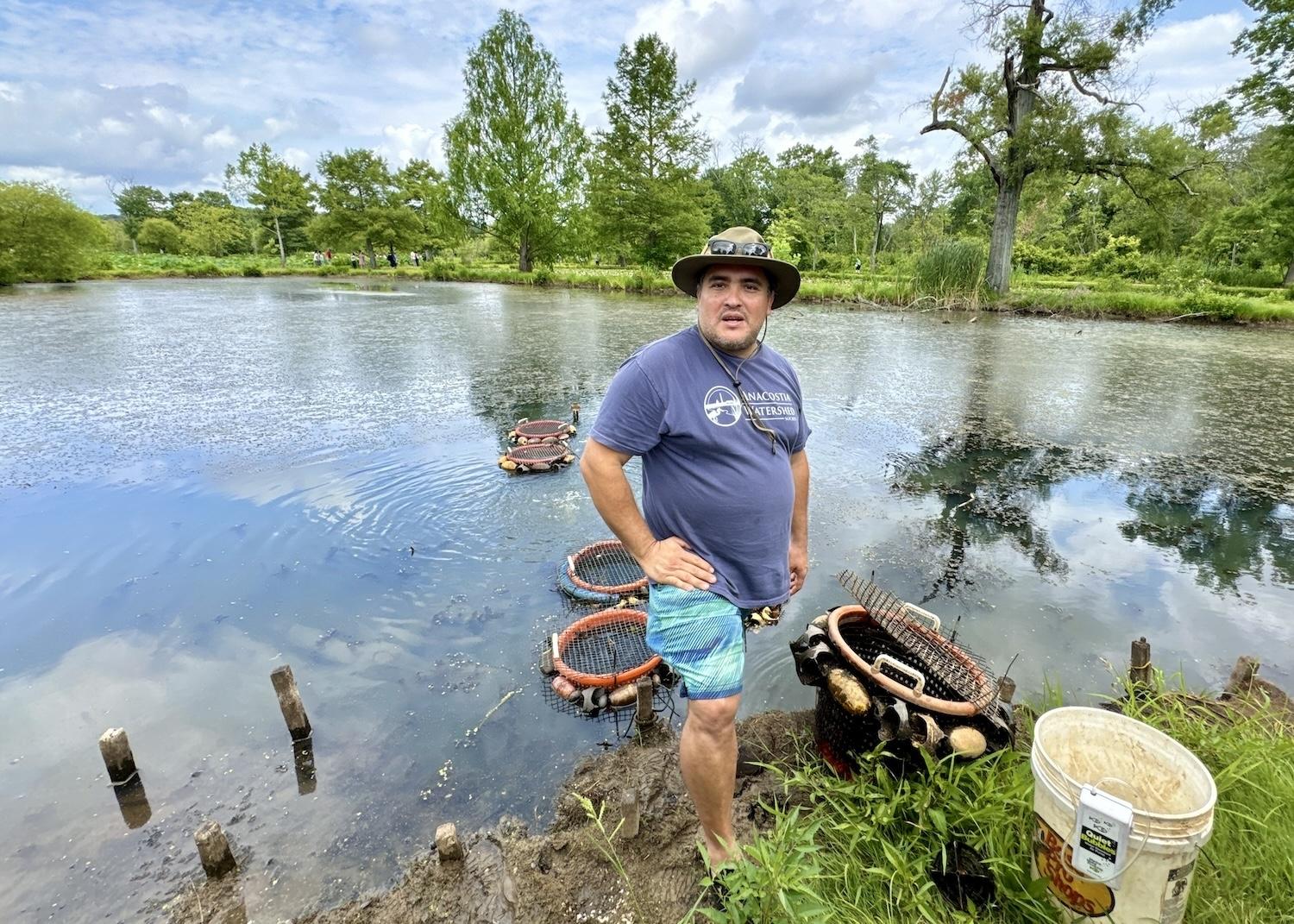
Jorge Bogantes Montero, of the Anacostia Watershed Society, collects mussels raised in Kenilworth Park & Aquatic Gardens/Jennifer Bain
I catch wind of a special walk and talk planned for the next day, so return to join the Anacostia Watershed Society to learn about the mussel restoration work it has been doing since 2018.
From a lily pond just outside the Kenilworth visitor center, natural resources specialist Jorge Bogantes Montero pulls mussels from baskets in a staging area. About 20 of us will help release 43 of them — 17 eastern elliptio, 20 alewife floaters and six eastern lampmussels.
These aquatic animals with soft bodies and hard, hinged shells can filter up to 20 gallons of water a day, removing sediment from the water and depositing it on the river bottom. They eat E. coli and other types of bacteria. This encourages aquatic plant life that supports habitat for other animals.

The Anacostia Watershed Society prepares to release three types of freshwater mussels into Kenilworth Marsh. From top: Eastern elliptio, eastern lampmussel and alewife floater/Jennifer Bain
Pollution and habitat loss have made freshwater mussels one of the most imperiled animals in North America. The watershed society works with partners like the NPS to restore these unsung heroes of the Anacostia River. So far it has released more than 36,000 mussels into the river.
We take a forest path through the park to the Anacostia Riverwalk Trail and wind up on the bank of the Kenilworth Marsh — which is under NPS care — across from the boardwalk I had strolled on the day before.
“The tide is starting to come in. Oh, look at the osprey,” says Montero. “Yeah, so this is a very special place. On a sunny day like today, the mussels are filtering. It’s like a happy day for mussels.”

Getting ready to toss mussel M112 (an eastern elliptio) into Kenilworth Marsh/Jennifer Bain
The society has successfully propagated five kinds of native mussels for this project. Today will be the first time eastern elliptio mussels will be released.
“So we’re just going to chuck the mussels and that’s completely fine,” says Montero. “At this point they are really strong.” I dip my hand in the bucket and pull out mussel M112 — an eastern elliptio — and throw it into the water. Then I do the same with D362, an alewife floater. The second mussel flies straight up and then down and I fret that a muskrat will get it at low tide since it's so close to shore.
Still, I'm thrilled that as a visitor to D.C. I get to do something so unique for such a special aquatic ecosystem. I thank Montero and return to Kenilworth for a picnic and one final stroll around the ponds. It's the weekend now and getting crowded. The herons are hiding, but the water lilies and lotus are loving the attention.

People gather for a mussel walk/talk at one of Kenilworth Park's water lily ponds while other visitors visit the lotus and lily ponds in the background/Jennifer Bain

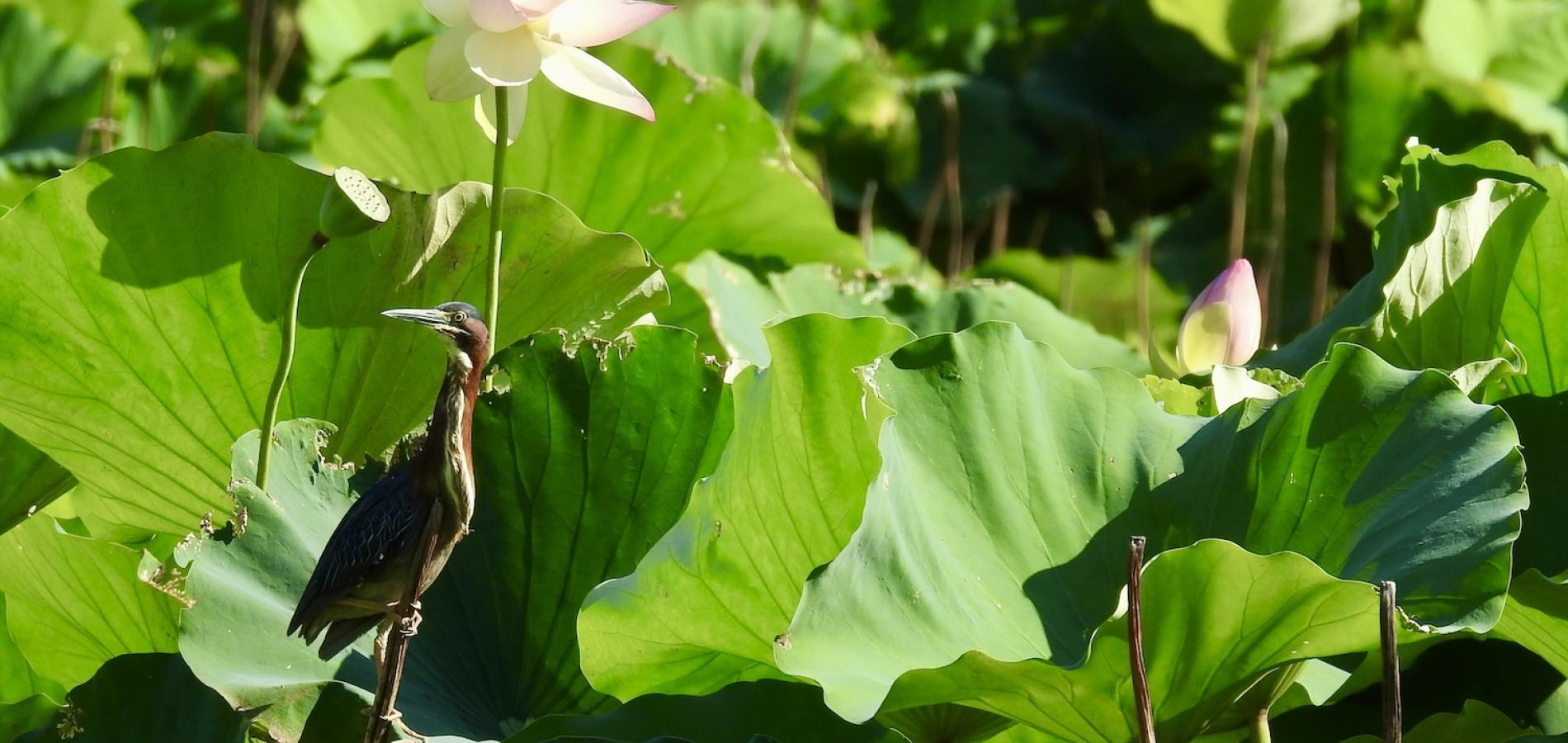

 Support Essential Coverage of Essential Places
Support Essential Coverage of Essential Places






